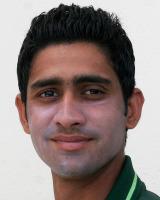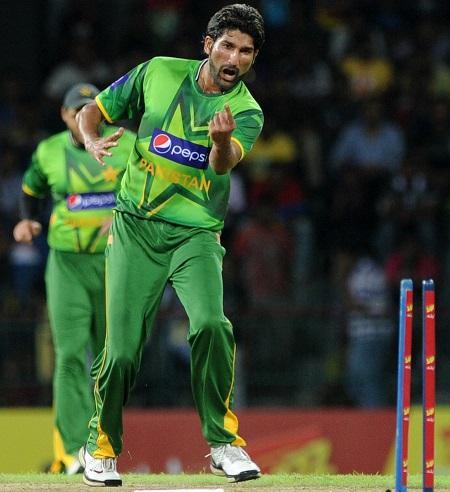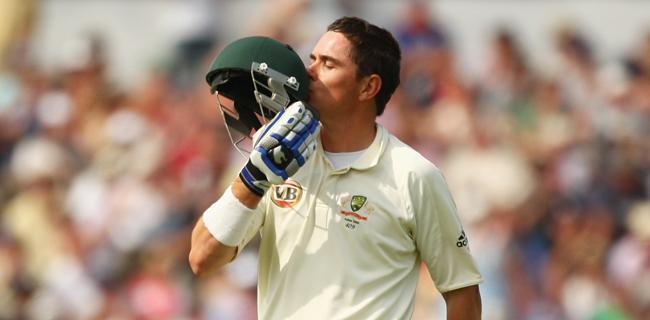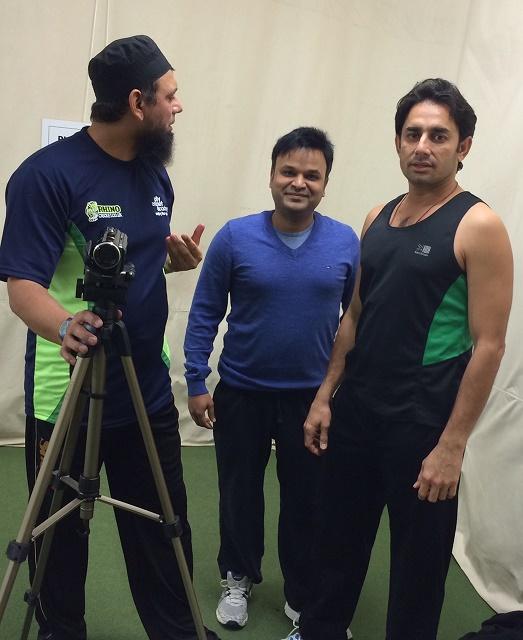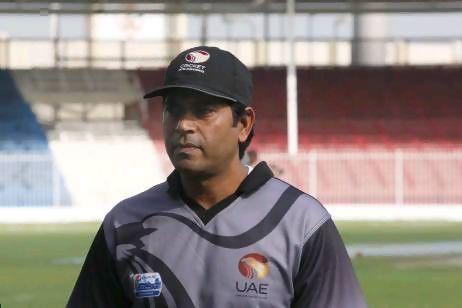PakPassion.net caught up with Saleem Jaffar to discuss his career as an international player, his role as a selector, coach, and in general, his views on fast bowling prospects and the cricketing structure in Pakistan.
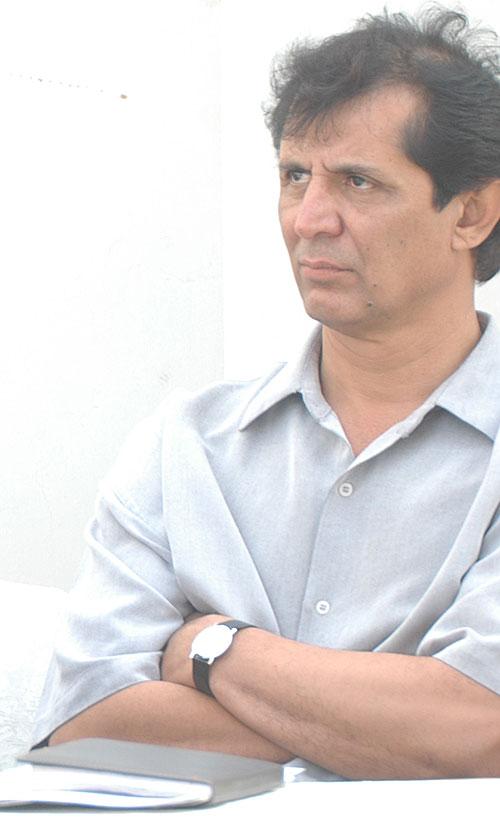
By PakPassion Staff (8th January 2012)
Saleem Jaffar, a former left-arm fast bowler hailing from Karachi, featured in 14 Tests and 39 ODIs for Pakistan. After having a great domestic season (between 1985-1986), he then made his debut in both formats against West Indies. With an international career spanning just over 5 years, he displayed his best outing by obtaining his only Test five-for against New Zealand at Wellington (with the figures of 8-134).
Apart from his career as a cricketer though, Saleem Jaffar also acted as a selector from 2007-2009 (was also a Chief Selector during this period), and has also been the coach for various domestic teams in the Karachi region.
As he is known for having a keen eye on cricketing affairs, PakPassion.net caught up with Saleem Jaffar to discuss his career as an international player, his role as a selector, coach, and in general, his views on fast bowling prospects and the cricketing structure in Pakistan.
PakPassion.net: I will start off by asking you about your career, and then we will get to the selection process [and your selection role] and then a bit about your coaching. So to begin with, tell us a little a bit about the beginnings of your career. When you started your career, which batsman did you think was really talented and to whom was bowling a tough job?
Saleem Jaffar: Actually, as far as bowling in a cricketing career is concerned, the problem is that sometimes the top order batsmen that you have-meaning, the well-established batsmen (a team?s main batsmen)-sometimes, they don?t bother you as much and in just one delivery you can get the task done. Other times, one might face a problem where the tail gets stuck/does not get out easily.
Then it also depends on the conditions, on the wicket?s behavior, and it depends on how the wicket is supporting you. If the wicket provides support then you don?t have to worry too much, but if you are bowling to someone on a batting track then there are some difficulties involved. Though no doubt, in every team, for instance when we played against India, there was Gavaskar, Mohinder Amarnath, and these were such players for whom one really had to come up with a plan in the night [chuckles], you know, you had to wake up [from sleep] for these players.
Then there were players from West Indies. There was Greenridge, there was Haynes, there was Richards, and these were such batsmen for whom every person really had to create a plan. For every team?s top order, they used to have some really difficult batsmen and for them, it was really necessary to come up with a plan and you had to think.
PakPassion.net: Tell us a little bit about that 18 runs over in the 1987 World Cup semi final against Australia. You bowled the last over and conceded 18 runs, and Pakistan also lost the match by 18 runs. So, what happened? What was the pressure like and did anyone say anything to you after the match [in terms of mistakes that you made]?
Saleem Jaffar: No, nothing of this sort happened. Actually, if you look at it one way, then that was totally, entirely a bad day for the Pakistani team. No doubt, the Pakistani team were favourites in that tournament but it was a bad day in the sense that if you take a look, then you will see that Tauseef Ahmed, while bowling, got hit by a ball and he had to get stitches. Saleem Yousuf, while wicket-keeping behind the stumps, got hit in the mouth by the ball and he also received some stitches, and then Imran Khan was given out on a wrong decision.
Right, and as far as I think conceding runs is concerned, if one takes a look there, then I actually wasn?t going to bowl that over. Imran Khan?s routine was that if one had to prepare some bowler or get them to bowl, then he would get one or two overs beforehand for warm-up.
My team also said that Imran had some overs left [he also had to bowl some overs] and then all of a sudden he made me do the bowling. If you look at that over, then the problem that occurred was that the fielding support was minimal. If you look at Ijaz Ahmed, he conceded a boundary by letting the ball go between his feet and those entire four runs got deposited into my account. Then, the two runs from the overthrow also got added to my account. In this way, these unnecessary runs got added to my account and if you look at cricket nowadays [like Twenty20 cricket], now, if a bowler concedes 22, 25, or 26 runs, then we forget about that.
It?s just that it was totally a bad day for us in terms of batting, bowling, fielding, and I guess it wasn?t in God?s will so we didn?t win that match.
PakPassion.net: When playing against West Indies in a match, you were at non-strikers end when Pakistan needed 14 runs to win, and Courtney Walsh didn?t run you out while you were backing up. Tell us a bit about this in terms of how you felt, and did you talk to Courtney Walsh after the match was done?
Saleem Jaffar: I just want to say that it was about Courtney Walsh?s sportsman spirit. He acted as a really good sportsman. The plan was that Qadir had the strike, and he said that he wanted to take the strike upon the last ball because the game had turned out in such a way that he was the one who had to make runs. So we made one plan that we had to take a single and even if the wicket-keeper gets the ball, then we would still go for the run.
Hence, I had this intention in my head and at that time, that law didn?t apply which is applied today on back foot landing-if a bowler lands on the back foot landing then the non-striker end can leave the crease. But at that time, this law wasn?t in place and I did leave the crease a little early but this was due to Courtney Walsh?s graciousness and sportsman spirit; I mean he warned me and if you take a look, in such big games bowlers didn?t get the batsmen out like that. They wouldn?t bowl but would rather warn the batsman and based on this warning custom, Walsh informed me not to leave the crease too early.
Really, this was his graciousness that in such a big match he did this because after that ball there was a six due to which Pakistan won and qualified for the semi final match, while West Indies got disqualified. I appreciate this because that act [by Walsh] is a great gesture.
PakPassion.net: My next question is about former Pakistani players who say that tape ball is Pakistan?s secret behind the fast bowling production line. On the other hand, some say that tape ball has been detrimental for Pakistani fast bowlers and batsmen. What do you think about this issue?
Saleem Jaffar: Look, tape ball is initially your grassroots level bowling. When you are young, 10 or 11 years old, then they first hand you the tennis ball and that?s where you begin to develop your cricket. But yes, when you come into the fold of professional cricket, when you start playing in good club cricket teams, then tape ball does not support you and persisting with it can be a detriment to your cricket.
So I will just say that tape ball is not really related to professional cricket. As far as the talk about fast bowlers is concerned, in my opinion, fast bowlers? inspiration and the way in which fast bowlers started coming to the fore; that in my opinion was due to Imran Khan because he brought the fast bowler trend to Pakistan. His action, his run-up, his bowling style, and the way his ball possessed pace; the juniors/generation of that time became quite impressed because of this.
After that, the boost that fast bowling got and the fast bowlers that began to emerge-Wasim Akram, Waqar Younis, Aaqib Javed, Shoaib Akhtar, Mohammad Asif, Mohammad Amir-ever since this line of fast bowlers started; I mean if you compare our fast bowlers with India, then no doubt we produce better fast bowlers rather than batsmen. India has it the other way around, as they produce better batsmen rather than fast bowlers.
I believe that in higher levels of cricket, your skills gets damaged if you play with the tape ball.
PakPassion.net: So Imran Khan brought the tsunami in fast bowling as well [laughs]?
Saleem Jaffar: Yes, no doubt he brought the fast bowling tsunami too, certainly.
PakPassion.net: Nowadays he is bringing a different tsunami, so that?s why I mentioned it.
Saleem Jaffar: Yes, yes. He indeed brought the fast bowling tsunami as well [chuckles].
PakPassion.net: My next question is that as compared to when you used to play cricket and how it is played currently, do you think overall it has improved nowadays?
Saleem Jaffar: If you look at cricket quality wise, then I don?t think it has improved a lot. But if you look at it commercial wise and if you observe the cricketing workload, then that has increased if you look at different forms of cricket.
And these fluctuations in cricket, because of it, it has become very difficult to assess cricket players. For instance, let me give the example of our domestic cricket just now: Recently, the T20 tournament finished and after that, the Quaid-e-Azam Trophy started [a 4 day tournament]. These various cricket formats that we have-such as jumping directly from T20 cricket to 4 day cricket, or jumping directly into Test cricket and then when that finishes, jumping in to one-day cricket-the thing is that these 3 forms require different planning and also have a different ball that is used in the game.
In T20 or one-day cricket, the cricketers play with a white ball and then in other forms, they play with the red ball. Both balls have a difference in their hardness, color coating, sight screen usage; meaning that these are different forms of cricket and so, the players have this load on them and this stress due to fluctuation in cricket is quite difficult. In my time, no doubt, this didn?t happen too much.
However, quality players in my time were perhaps much better, either as batsmen or in some other roles. But I will say that the one thing which has improved a lot is the fielding. Fielding areas nowadays have improved a lot and are of better quality as compared to cricket in my days. A lot of changes have occurred in cricket and especially, the changes which have taken place have transpired in the fielding. Nowadays, fielders have begun to slide more often, throwing has improved a lot, and so I will say that in my opinion, if you look at it from the perspective of financial benefits even, then currently, cricketers have much more benefits and cricket is much more stressful these days.
PakPassion.net: Do you feel that nowadays players get over-coached too much?
Saleem Jaffar: Over-coached? The problem is that in my time, there was no concept of coaching and there were no academies, there was nothing. Whatever we played, we did so under one?s captaincy. We only had manager?s facilities provided to us, that?s it. However much we played, we played under Imran. Whatever basics we learned, whatever planning we learned, everything that we learned, we learned from Imran.
For everything we followed him and what he had to say, but these days, the coaching system has really been on the rise. A child turns 10 years old and his parents put him in a coaching camp. A lot of coaching clubs have begun where children are provided with coaching on cricket. A child passes through a certain coach and then he comes into the club cricket system and here, the coaches are different. Then he goes up to the regional level and there, the seasons coaches [the PCB coaches] are present [just like I am a coach for the Karachi region]. These children come under our responsibility and then have to listen to us, and then if they proceed further ahead, they go towards NCA or national cricket coaches.
So the cricketer nowadays has become confused.
PakPassion.net: This was my point as well that too many coaches are instructing the players nowadays.
Saleem Jaffar: Too many cooks will spoil the food; this is what the problem has become now. So on one child, in his 10 or 15 year career if 7 or 8 coaches are present, then that child becomes confused. This is a bit of a problem for players nowadays and it is necessary to think about this issue. If only one coach is present in professional cricket, players should follow him and listen to him and this is very important because otherwise, the players nowadays will get confused.
PakPassion.net: The next question I ask will be regarding domestic matches. You have been the coach for various Karachi teams, so provide us with your thoughts on the standard of cricket in Karachi?
Saleem Jaffar: In my opinion, the regions that I have looked at or have heard about-for instance, there is the Lahore region, Peshawar region, Abbottabad region, etc-I felt that selection wise, here, the selection that is carried out is much better.
Or I guess another advantage is also that in Karachi there are two teams which are created [it is a bigger city]. Two teams are made so this acts as one advantage as well. But then again, sometimes I feel that 2 teams are not enough.
But I will say that this time around in the Karachi region, I was involved in the selection for the first time-there was Mr. Bukhari present, who is the president here-and in my opinion, the selection method went quite well; like the way one was hearing that one may experience unnecessary pressure while selecting, this sort of thing didn?t happen in the selection process.
Mr. Bukhari was quite flexible, Mohsin Khan too [who is chairman of the selection committee] was present for the selection, and regional coaches were there too like Azam Khan and myself were present there. So in a very good way, the selection process was quite black and white-the boys who performed well, those were the players upon which the basis of the team was made.
Hence, I didn?t think that there were any problems with the selection methods in the Karachi region. And in this way, the unnecessary pressure that one may experience during the selection process, this wasn?t felt and it is better this way.
PakPassion.net: I will ask you one more question on this topic ? Karachi used to produce very good batsmen in the past. However, the batsmen coming from there nowadays ? batsmen like Khalid Latif, Shahzaib Hasan and Khurram Manzoor ? they have technical defects. Why is it so?
Saleem Jaffar: I think the structure of our Club cricket has deteriorated. The Associations and the regions will have to look into this matter. Club cricket is not competitive anymore. I have heard that the players in Club cricket these days ? the clubs offer them monthly salaries for playing. Players are more inclined towards money now, I think. If you look at the Ramadan cricket here, it is a weird Jumma bazaar of cricketers ? they bid for the players. ?Play for our club and get 1 lakh rupees.? ?Play for our club and get 2 lakh rupees!?
Money has poured into club cricket as well. I mean people who used to run these clubs in the past ? the patrons of these clubs ? they are not present any longer. They were very passionate people. They had no other interest with cricket apart from love for the game sports. They formed teams only because of that love. They used to gather the boys themselves, and spent money from their own pockets and clubs were built. Those clubs were very good. I remember that when we used to go to watch matches of a club, we used to rate the club, counting how many First Class players played for that particular club. This is how rating was done. But look at it nowadays, if a Pakistani player is playing in club there is not much value! So if you look at it [club cricket], the quality has gone down drastically. One of the reasons is that too much money is involved everywhere now. Player is running after money instead of working on his skills and passion for the game because he is more hopeful of earning money from there. So he doesn?t care which club I?m playing for, what my reputation is or what my standing is, new players doesn?t bother this anymore.
PakPassion.net: Tell us a bit about the difference between the type of cricket ball used in our domestic cricket and the one used in international cricket.
Saleem Jaffar: Look domestic cricket, the Quaid-e-Azam Trophy has recently concluded. So I am also writing a letter to the board. This is what I wish to write that these are professional cricketers, and this is the highest level of cricket in Pakistan. After this, the player goes on to play for the country. He gets selected in the Pakistan team on basis of his performance [in domestic cricket]. So in my opinion, same balls should be used in this cricket as in international cricket where the player has to play later on. International cricket is played with a Kookaburra ball and in England, it is played with the English ball Duke. But mostly, cricket is played with Kookaburra ball. So, in our domestic cricket too, Pakistan Cricket Board should use it because Kookaburra is an entirely different ball. It?s behaviour is different, its bounce is entirely different as compared to the Pakistani ball. The feel of the leather is different as is the seam. When the player has to play with Kookaburra ball in international cricket in future, he should have ample opportunity to practice on it from here [domestic cricket] only.
PakPassion.net: Tell us a bit about Mohammad Sami. You have worked with him in the past when you were the coach of Karachi team. When he came on the scene, he seemed to have a lot of potential. But he could not live up to it. Why do you think he couldn?t be successful?
Saleem Jaffar: Well, I have seen very few cricketers who are natural. Sami is one of them ? he is a natural bowler. I think he can be considered an allrounder now. He has scored almost 600 runs this season. He is outstanding fielder, can field anywhere in the field. He has taken outstanding catches in the slips. He is a very good outfielder, he is athletic. I have talked with him a lot. When he was the captain, I discussed with him and I told him that he is a good bowler in the longer version of the game. But for contemporary cricket ? the Twenty20 format and One Day cricket, he needs to add variation to his bowling - variation in the sense that he needs to develop his slower one, develop his yorkers and the change of pace, which is very important for bowlers nowadays. If a bowler cannot vary his pace and doesn?t have variation in his bowling, he cannot be successful in this era. He [Sami] understands this. I have seen him working on his slower one and the yorker this year. However, I would say that his pace and his skills didn't get much fame in international cricket. I have watched domestic cricket this season ? Sami was the one who was bowling the fastest. He was bowling with good pace ? he even clocked 150 kph. He bowled very fast and we saw the batsmen feeling uneasy when facing him. We got to play more matches on the Karachi wicket this time around. Had we played more matches in Punjab, Sami would have been [the] leading [wicket-taker] today.
PakPassion.net: You have made an interesting point that Sami was bowling with good pace. Did you see any other bowler in the domestic circuit who was bowling fast ? may be even clocking 90 mph?
Saleem Jaffar: Among the fast bowlers in domestic cricket ? no, I don?t think so. I didn?t see any bowler who was bowling as fast as Sami. I haven?t seen such a bowler. We watched the entire Quaid-e-Azam Trophy and it is really disappointing to see that we did not come across a single find that could be termed as the future of Pakistan cricket. We will have to improve our domestic cricket ? we will have to make the format more competitive. We will have to change the character of the wickets, we will have to change the ball. Another factor is that International cricket is not being played in Pakistan. So I have seen guys in domestic cricket ? they seem to be very disappointed. So this is a psychological effect that the players seem visibly disappointed. Also, in the last one or two years, I have seen that there haven?t been many Pakistan A tours. I think PCB needs to address this issue and take serious steps in this regard. Pakistan A and Under-19 cricket will benefit us. If we need supplies to produce a material, this is where we can get them from. There haven?t been many tours for Pakistan A in the last one or two years ? we will have to organise them. We need to invite A teams from various countries, which might also help in restoring international cricket in Pakistan. We will have to promote Under-19 cricket extensively. This is our future and this is where we will get our product from.
PakPassion.net: Anwar Ali was regarded as a fine prospect when he came into Under-19 cricket. Why do you think he has not developed much yet?
Saleem Jaffar: I have had discussions with Anwar Ali. He was with me during the Pentangular Cup last time around when I was the coach of Sindh team. I have seen him in the last three or four years and even he himself says that he has become confused. He went to the NCA, and he has gone through three or four coaches and has been left confused. Self-coaching has also played a part in it - he did some things that probably did not befit him. In addition to this, the main problem that I find in Anwar Ali is ? look as a coach, we cannot really work on a player?s basics and his skills because we are competing in a tournament, and when we are in the middle of a tournament, we cannot experiment with a player?s action or his technique. The only thing we ask from them is that you are competing in a tournament, so you have to deliver. During off season, these players go to England and I have noticed that their thinking has changed a lot. They think that working out in the gym, running and doing exercise is what qualifies as hard work. I have noticed that they do not work much on their skills. The main thing is your bowling ? and I think they do not work on it when they go to England. During their off days, they spend more time in the gym, running and doing exercises. This is not enough for bowling ? if you want to become a good bowler, you have to do good bowling! You have to BOWL more than doing all these things. If you want to become a good batsman, you have to bat for long periods of time. It strengthens your back, it strengthens your arms. Bowling is an exercise in itself, I think. If you keep bowling, your muscles do get strengthened. Bowlers are working more on their fitness than on their skills. So this is also a big issue. A bowler considers his work-out and training as hard work. In fact, hard work is to bowl for long periods of time, to bowl long spells and then move on to his [fitness] training. This is what is called hard work.
PakPassion.net: What are your thoughts on Sadaf Hussain, Mohammed Talha, and Imran Khan - the new pacer who took 58 wickets?
Saleem Jaffar: Imran Khan still needs some time to develop - I would say another year or two. There is no doubt that he is a talented bowler as he has taken these wickets. To make him a finished product, there needs to be some work put in it. However, it is difficult to judge a bowler's potential after only one season. This is the problem with fast bowling where after only a year, people feel the bowler is outstanding. When the bowler plays 2-3 seasons and his muscles start tiring after long spells, pace starts dropping, focus starts dropping, and he becomes more injury-prone. Every bowler needs to go through this phase first. We tend to bring bowlers very early and often times, they don't live up to the expectations. The bowlers then start to face injury problems, pace starts to drop, and then we feel the bowler has slowed down.
There is also the difference of the ball. The Pakistani ball is harder and comes out faster, while the Kookaburra is slower and when the ball gets older, it becomes even slower. These are factors that we need to focus on because if we need to develop a player, they need to play at least 3-4 years of domestic cricket. Within that time, the bowler plays 40+ matches and ends up taking 100 or more wickets. As a result, the bowler has gained that experience, information about his injuries are well known by then, and any body weaknesses can be worked on. In professional cricket, you need to guide each bowler through this process and this is something that is very important.
Sadaf Hussain and all the others are all very good bowlers and they can be further groomed. However, they are not genuine fast bowlers. They can perform well on green seaming wickets, but in international cricket you need pace, clocking 140 KPH+ regularly.
Mohammad Sami is the only genuine fast bowler that I have seen and in front of him, the rest seemed very slow to me. When Sami would bowl, you could see a clear difference in pace between him and the others. Even when you compare Sohail Khan and Tanvir Ahmed, both of whom have played for Pakistan, with Sami, you could see a clear difference of pace. I feel that in International cricket you need genuine pace to be a successful pace bowler, regularly touching 140 KPH.
These are all decent bowlers bowling in the 130 KPH range, but they need to add more pace. In English conditions where there are bowler friendly wickets, these bowlers will do well. In the subcontinent, where the wickets support the batsmen, that is where you need to rely on pace ? especially pace in the air.
PakPassion.Net: When you were a selector, what was the biggest challenge that you faced? Were there any political interferences in selection?
Saleem Jaffar: There were no political interferences and cricket selection is a very 'black-and-white' process. Especially, in today's day and age, media interest plays a big part. In any given press conference, there are probably 100+ media related persons and handling those questions is not an easy job. With such accountability, you need to follow this 'black-and-white' process where selection is solely based on the player's performance. There are certain scenarios where this is not easily applicable.
For example, if you have Inzamam ul Haq in your team playing a certain position in the batting order and you have someone who has scored more runs playing at that position, you can't automatically select him until the position is vacant. Therefore, there are times when players perform extremely well at the domestic level, but are not selected for the Pakistan team because there is no vacancy for that particular spot. When you have players like Wasim Akram and Waqar Younis in your team, you can't simply drop them to give someone else a chance. That?s just bad luck for the guy who has done well but cannot find a spot. What will not happen is that we fill a vacancy with a bowler who has got 30 wickets compared to one who has 80!
PakPassion.net: You were a selector when Geoff Lawson was coach. There were problems between Geoff Lawson and the chief selector of that time. You often times played the role of a mediator. In your view, should the Pakistani coach be foreign or domestic?
Saleem Jaffar: It really depends. From what I have seen, foreign coaches are very organized and they conduct themselves in that manner. They have plans laid out for every single practice session. Before any match, they have done their research and leverage technology as part of their analysis. With local Pakistani coaches, they will provide the same, if not better advice than the foreign coach. The problem is that Pakistani coaches are not very organized.
With foreign coaches, the practice sessions are organized and their research is a lot better and much more thorough. That is where the main difference lies in. I have also noticed that our players are much more likely to listen to a foreign coach. This is not to say that we don't have good coaches in Pakistan. We've had our share of match-winners like Javed Miandad. Remember these people didn?t just win matches with no skills ? they had something in them which help them be so successful. I've seen him when he was coaching Pakistan and he would give outstanding batting tips. I feel that we need to focus on putting our legendary players in the coaching academies so they can create the products for the future [can help to groom players from the onset].
Also, foreign coaches have better man-management skills and they know how to deal with players. However, when a player has a problem and if the coach is a foreigner, the language barrier will definitely prevent the player from discussing the issue. It's like a going to a doctor - if you go to him and can't properly describe your situation, he won't be able to diagnose you. Likewise, if you are unable to express your feelings to the coach, there is no way he is going to be able to rectify your problems.
PakPassion.net: Do you support the idea of having day and night Tests with pink/orange ball?
Saleem Jaffar: Cricket's charm is with the white and red ball, played in day time. The real charm of Tests is the white clothing and red ball along with water, lunch and tea breaks ? even rain breaks are all part of the game. In my view, the experience won't be the same with day and night Test cricket. We already have two formats - T20 and One-day that are played in the evening and that is more than enough in my view. Therefore, I feel Test cricket should be played only in the day format.
PakPassion.net: Thank you Saleem Jaffar for taking time out of your busy schedule.
Saleem Jaffar: Thank you.
